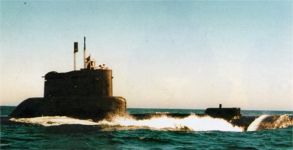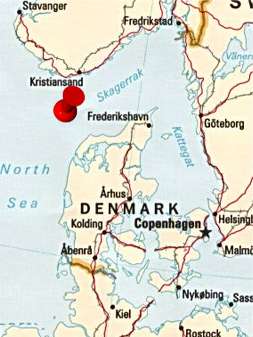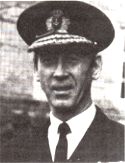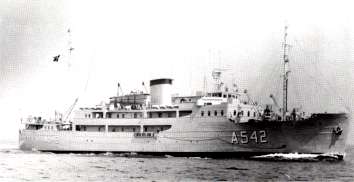|
You are here: 4Campaigns & Battles4Index4NARHVALEN reported missing |
|||||||||||||||||||||||||||||||||||||||||||||||||
|
Submarine NARHVALEN reported missing (1970):
Admiral Danish Fleet Reports the Submarine NARHVALEN Missing
|
||||||||||||||||||||||||||||||||||||||||||||||||
|
Submarine
NARHVALEN |
Heading for NATO exercise in Norway The Danish submarine NARHVALEN was, together with the submarine tender HENRIK GERNER and the submarine SPÆKHUGGEREN on its way to the Norwegian naval base at Håkonsvern in Bergen, Norway, to join a plan- |
ned NATO exercise.
Just west of Skagen, NARHVALEN started a planned dive, which was planned to last for approximately 60 hours. This dive wasn't suppose to hinder the submarine from surfacing its antenna to communicate with land or other units.
During any deployment, a submarine are supposed to send a message with its position every 24 hour, so that Admiral Danish Fleet in Århus and possible escort vessels knows that everything is okay onboard the submerged submarine.
Missing radio contact caused heavy activity
The navy hadn't had contact with the submarine since Tuesday evening at 2130, and it was now Wednesday evening.
The missing signal from the submarine, therefore, created heavy activity in Århus as well as onboard HENRIK GERNER which was in the area, and at the same time acted as command ship in the submarine squadron.
The weather in the area was bad, with poor visibility, large swells and wind from the west, blowing at around 14-17 m/sec.
During the next hour, tries were made to gain contact with NARHVALEN via radio, but no contact was established.
A procedure called SUBMISS - Submarine are lost, was executed.
|
Experienced Sub Commander The commander of NARHVALEN, the 32 year old, lieutenant-commander Peer Rasmussen, was an experienced submariner. Lieutenant-commander Peer Rasmussen had already served onboard various submarines for the last 5 years, also on the elderly DELFINEN Class, when he on April 3, 1970, was given command over the Navy's newest submarine. Just prior to his promotion, he had been comman-ding officer of the submarine SPÆKHUGGEREN. Furthermore, he had served roughly 2 years as executive commander in the submarines of the DELFINEN Class, before commanding the SPÆKHUGGEREN. |
Lieutenant Commander |
Peer Rasmussen had also served a good year on the small corvette FLORA.
Curiously, his two former vessels, SPÆKHUGGEREN and FLORA, was about to participate in the search this September night.
The navy's newest submarine
The 44 meter long submarine, the newest submarine in the navy, had just been taken into service earlier the same year. The submarine was built at the Navy Dockyard, as the first of two submarine, which hull was based on a well tested German design.
The two diesel engines was able to give the submarine a top speed around ten knots in the surface, while its electric engine gave the submarine 17 knots submerged.
The submarine had a crew of 21, which included 6 officers. Also onboard was conscripts, among these, the Cook.
The search starts
At the very same time as the submarine was reported missing, an intensive search had been started. At first from those units of the Danish Navy which was already in the area, and at the same time, the civilian traffic in the area was asked to keep a lookout for the missing submarine.
|
The submarine disappeared in Skagerak around 10 miles south of Lindenes in Norway |
Shortly before midnight, a rescue helicopter from Air Station Aalborg was asked to participate in the search. The helicopter flew several times along the estimated route of NARHVALEN without seeing anything. Around 0330 the helicopter had to return to Aalborg without having seen the submarine. Meanwhile, the intensive search continued at sea. More ships, planes and helicopters joins the search It was still presumed, that the missing contact with the submarine was due to the vast distance and the bad weather. Admiral Danish Fleet on the other hand, wouldn't risk anything and all available material, ships and aircraft, was alerted and engaged in the search. |
Besides HENRIK GERNER and SPÆKHUGGEREN, who was already in the area, several others of the navy's ships was engaged in the search.
The navy puts the frigates PEDER SKRAM and HERLUF TROLLE, the small corvette FLORA, coastal minelayer FALSTER and the fishery protection vessel FYLLA in to the search, along with the rescue vessel NORDJYLLAND. Furthermore, a number of cutters from Naval district Kattegat participated.
The commanding officer of PEDER SKRAM, Commander Otto Westergaard, are orderd to take charge of the search in the area (on scene commander), while Admiral Danish Fleet still retains the general control and coordination, including the search from the air.
From Norway, a frigate are participating and a destroyer from Holland are enroute. At this time, Sweden has announced that the submarine-rescue-vessel BELOS are ready to leave the Swedish city of Gothenburg if any assistance are needed.
2 German aircraft, British and Norwegian aircrafts and helicopters participates along with Danish helicopters in the intensive search. The search covers a 40 kilometers wide zone along the 220 kilometers route that NARHVALEN was suppose to follow.
|
Relatives are notified Minister of Defence Erik Ninn-Hansen was informed on the missing submarine last night, just as Commander of the Danish Navy, vice-admiral S. S. Thostrup, chose to follow the search from Naval base København. Meanwhile, a number of local police stations was put to work, since relatives had to be informed of the missing crewmembers, and inform them concerning the situation. This was done so that they shouldn't hear about the search in the news and not know about it. At the same time, it was stressed to the relatives, that there was no reason to fear anything, yet. Found at dawn |
Chief of the Navy, |
At dawn on September 10, a total of 6 nations had ships enroute the search area, just as aircrafts and helicopters were ready to resume the search for the missing submarine.
|
The submarine tender
HENRIK GERNER |
Around 0500 HENRIK GERNER gained visual contact with NARHVALEN and one of the biggest search and rescue operations in Skagerak had come to an end. The missing "all-well"-signal was due to radio equipment failure on board NARHVALEN and that had hindered the crew from sending the signal at the appropriate time. |
Admiral Danish Fleet reassures the relatives
Presumably, no one onboard the submarine had the faintest idea what gigantic effort and material had been put into the search.
All in all, 34 naval ships and 6 civilian ships had participated in the search, together with eight aircraft and an unknown numbers of helicopters.
Immediately after the communication with the submarine had been reestablished, the Commander of The Navy O. Brinck-Lund chose to write a personal letter to the relatives of the crew, just to explain the situation.
44Read The letter to the relatives
|
Sources: |
||
|
" |
The daily newspapers POLITIKEN, EKSTRA BLADET, BERLINGSKE TIDENDE, BT, AALBORG STIFTSTIDENDE, September 10, 1970 |
|
|
& |
Danske Søofficerer 1933-1982, edited by S. E. Pontoppidan and J. Teisen, published by Søe-Lieutenant-Selskabet, Copenhagen, 1984 |
|
|
& |
Flådens skibe og fartøjer 1945-1995, by Gunnar Olsen and Svenn Storgaard, Marinehistoriske skrifter, Copenhagen 1998 (ISBN 87-87720-13-2) |
|
|
44You are also referred to the Naval Bibliography |
||
![]()
- Do you miss a major event on this Site,
or do you hold a great story?
Are you able to contribute to the unfolding of
the Danish Naval History,
please
e-mail
me, enclosures are welcome.
Please remember to list your sources.
You can also use the Naval Web Forum on this web-site.
![]()
Follow the unfolding story:
Admiral Danish Fleet's letter to the relatives
|
MORE IN-DEPTH STORIES FROM |
|
The Explosion in Flensburg (1945) - Kieler Expeditionary Force (1945) - JUTLANDIA in Korea - Somebody just had to do it - NARHVALEN reported missing in the Skagerrak (1970) - The Battle off Gedser (1980) - Missile Incident at Lumsaas (1982) |
|
THE TOPIC STORIES: |
|
- Wars against England (1801-1814) - Reconstructing the Navy (1814-1848) - The 1st Schleswig War (1848-50) - The interim War Years (1850-64) - The 2nd Schleswig War (1864) - The long Period of Peace (1864-1914) - The Navy during the 1st World War (1914-1918) - The Interim Years (1919-1939) - The Navy during the 2nd World War (1939-1945) - The Cold War Period (1945-1989) - |
|
SEE ALSO: |
-
This page was last updated: -
This page was first published: February 23, 2003
Copyright © 2013-2016 Johnny E. Balsved - All rights reserved - Privacy Policy






